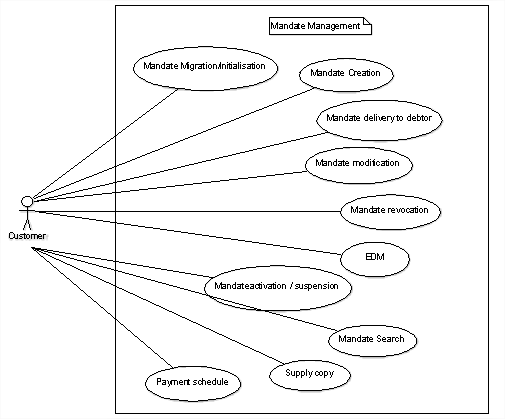Every SEPA paper mandate signed by a debtor client in favor of a creditor contains the following data:
Compulsory data relating to the mandate
-
Unique Mandate Reference (UMR);
-
SDD Scheme (i.e. Core or B2B) ;
-
Type of mandate: migrated, paper or e-mandate;
-
Transaction type: recurrent or one-off;
Compulsory data relating to the creditor
-
Creditor’s name;
-
SEPA Creditor Identifier (SCI);
-
Creditor’s address (number and street name); - inherited from the creditor object
-
Creditor’s town and postal code; - inherited from the creditor object
-
Creditor’s country; - inherited from the creditor object
Compulsory data relating to the debtor
-
Debtor’s name;
-
Date of signature;
Optional data relating to the debtor
-
Debtor’s identification code;
-
Name of the debtor reference party for which the debtor is making the payments (the third party);
-
Identification code of the debtor reference party for which the debtor is making the payments;
-
Email address;
-
Telephone number;
-
Fax number;
-
Place of signature;
-
Debtor’s language;
-
Debtor’s account number (IBAN);
-
Debtor’s bank code (BIC);
Optional data relating to the creditor
-
Name of the creditor reference party;
-
Identification code of the creditor reference party;
Optional data relating to the mandate
-
Identifier for the underlying contract;
-
Description of the contract;
-
UIR (see below).
The data in italics represent the minimum data that the mandate must carry to be registered in SEPA Payment Suite. However, these data are not sufficient to allow the issuing of direct debits in relation to this mandate.
As standard SEPA Payment Suite only supports the “Latin” character set, as defined in the EPC standard, for the creation of the UMR.
The main functions provided by SEPA Payment Suite in relation to management of paperless mandates are as follows:

Figure 2 : List of the main functions for mandate management
The functions are described in detail in the following chapters.